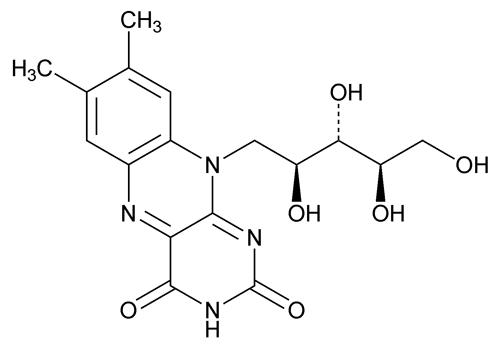Riboflavin
(rye' boe flay vin).
DEFINITION
Riboflavin contains NLT 98.0% and NMT 102.0% of riboflavin (C17H20N4O6), calculated on the dried basis.
IDENTIFICATION
• A. Color and Fluorescence of Solution
Sample solution:
0.01 mg/mL in water
Analysis:
Alternately expose to transmitted light and long-wavelength UV light.
Acceptance criteria:
The Sample solution is pale greenish yellow by transmitted light. By reflected light, it exhibits an intense yellowish-green fluorescence that disappears upon the addition of mineral acids or alkalies.
ASSAY
• Procedure
[Note—Conduct the entire Analysis without exposure to direct sunlight. ]
Standard solution:
Transfer 50 mg of USP Riboflavin RS to a 1000-mL volumetric flask containing 50 mL of water. Add 5 mL of 6 N acetic acid and sufficient water to make 800 mL. Heat on a steam bath, protected from light, with frequent agitation until dissolved. Cool to 25 , and dilute with water to volume. Dilute this solution with water to bring it within the operating sensitivity of the fluorometer used.
, and dilute with water to volume. Dilute this solution with water to bring it within the operating sensitivity of the fluorometer used.
Sample solution:
Transfer 50 mg of Riboflavin to a 1000-mL volumetric flask containing 50 mL of water. Add 5 mL of 6 N acetic acid and sufficient water to make 800 mL. Heat on a steam bath, protected from light, with frequent agitation until dissolved. Cool to 25 , and dilute with water to volume. Dilute this solution with water to bring it to the same concentration as that of the Standard solution.
, and dilute with water to volume. Dilute this solution with water to bring it to the same concentration as that of the Standard solution.
Blank:
Prepare as directed for the Sample solution, except omit the test specimen.
Instrumental conditions
Mode:
Fluorescence
Excitation wavelength:
444 nm
Emission wavelength:
530 nm
Analysis
Samples:
Standard solution, Sample solution, and Blank
Measure the fluorescence intensity of the Standard solution. Immediately after the reading, add to the solution 10 mg of sodium hydrosulfite, stirring with a glass rod until dissolved, and at once measure the fluorescence again. [Note—Depending on the final concentration of riboflavin in the solution, it may be necessary to increase the amount of sodium hydrosulfite to suppress the fluorescence activity completely. ] The difference between the two readings represents the fluorescence intensity (lS) due to the Standard solution. Similarly, measure the fluorescence intensity (lU) due to the Sample solution. Perform the Blank determination, and make any necessary correction.
Calculate the percentage of riboflavin (C17H20N4O6) in the portion of Riboflavin taken:
Result = (lU/lS) × (CS/CU) × 100
| lU | = | = fluorescence of the Sample solution |
| lS | = | = fluorescence of the Standard solution |
| CS | = | = concentration of USP Riboflavin RS in the Standard solution (µg/mL) |
| CU | = | = concentration of Riboflavin in the Sample solution (µg/mL) |
Acceptance criteria:
98.0%–102.0% on the dried basis
IMPURITIES
• Residue on Ignition  281
281 :
NMT 0.3%
:
NMT 0.3%
• Limit of Lumiflavin
Alcohol-free chloroform:
Shake 20 mL of chloroform gently but thoroughly with 20 mL of water for 3 min, draw off the chloroform layer, and wash twice more with 20-mL portions of water. Finally, pass the chloroform through a dry filter paper, and shake it for 5 min with 5 g of powdered anhydrous sodium sulfate. Allow the mixture to stand for 2 h, and decant or filter the clear chloroform.
Sample solution:
Shake 25 mg of Riboflavin with 10 mL of Alcohol-free chloroform for 5 min, and filter.
Blank:
Alcohol-free chloroform
Instrumental conditions
Analytical wavelength:
440 nm
Cell:
1 cm
Analysis
Samples:
Sample solution and Blank
Measure the absorbances of the Sample solution and Blank. Correct the absorbance of the Sample solution with that of the Blank.
Acceptance criteria:
Absorbance is NMT 0.025.
SPECIFIC TESTS
• Optical Rotation, Specific Rotation  781S
781S
Sample solution:
5 mg/mL in 0.05 M carbonate-free sodium hydroxide
Analysis:
Measure the specific rotation within 30 min of preparation.
Acceptance criteria:
 115
115 to
to  135
135
• Loss on Drying  731
731 :
Dry 500 mg at 105
:
Dry 500 mg at 105 for 2 h. It loses NMT 1.5% of its weight.
for 2 h. It loses NMT 1.5% of its weight.
ADDITIONAL REQUIREMENTS
• Packaging and Storage:
Preserve in tight, light-resistant containers.
Auxiliary Information—
Please check for your question in the FAQs before contacting USP.
| Topic/Question | Contact | Expert Committee |
|---|---|---|
| Monograph | Huy T. Dinh, M.S.
Scientific Liaison 1-301-816-8594 |
(DS2010) Monographs - Dietary Supplements |
| Reference Standards | RS Technical Services 1-301-816-8129 rstech@usp.org |
USP35–NF30 Page 4546
Pharmacopeial Forum: Volume No. 30(3) Page 929

